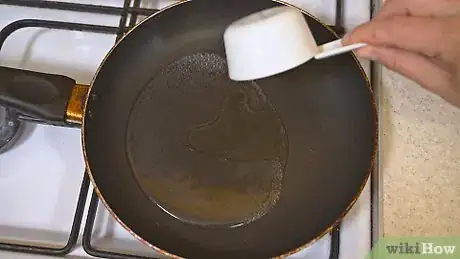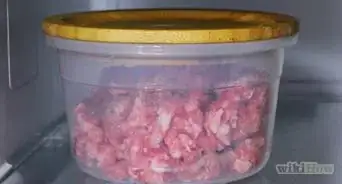This article was co-authored by Marrow Private Chefs. Marrow Private Chefs are based in Santa Rosa Beach, Florida. It is a chefs’ collaborative comprised of an ever-growing number of chefs and culinary professionals. Though regionally influenced primarily by coastal, traditional southern, cajun, and creole styles and flavors, the chefs at Marrow have a solid background in all types of cuisine with over 75 years of combined cooking experience.
This article has been viewed 909,191 times.
Making homemade Italian sausage requires a little patience and skill, but anyone with a true passion for cooking can accomplish the task. In this article, the first two methods explain how to cook pre-made Italian sausage that you can buy at your local convenience store. The last two methods explain how to make your very own Italian sausage from scratch. Even if you opt to make your own, you can still follow the first two methods to cook your sausage. Read on to find out helpful tips on how to cook and make delicious Italian sausage.
Ingredients
- 4 pounds well marbled pork
- 6 tablespoons dry red wine, omit if desired
- 1 tablespoon salt
- 1 teaspoon cayenne pepper
- 1/2 teaspoon fennel seed
- 1 tablespoon paprika
- 1 teaspoon crushed red pepper
- 2 tablespoons chopped garlic
- 2 tablespoons fresh chopped parsley
- 2 teaspoons freshly cracked black pepper
- 1 tablespoon of olive oil
Steps
Cooking on the Stovetop
-
1Heat a large non-stick skillet over medium heat. Add about a quarter inch of water to the pan, and a tablespoon of olive oil. Let the pan heat for about two minutes[1] .
-
2Add the sausage. Then, wait for the water to come to a boil. Place a lid on the skillet, and cook the sausage over medium-low heat for about fifteen minutes.
- When dealing with raw sausages, it's important to cook them whole and cut them afterwards.
Advertisement -
3Remove the lid. After fifteen minutes of cooking time, remove the lid and continue to cook the sausage over medium heat. Remember to turn the meat every two to three minutes.
-
4Cook the meat until it reaches a golden brown color. If you have a temperature gage, the meat should reach an internal temperature of 150 to 156 degrees F.
- If you prefer, you can also bake your sausages as described in the following method below.
Cooking in the Oven
-
1Preheat the oven to 400 degrees Fahrenheit (200 degrees Celsius). Line a shallow baking sheet with nonstick aluminum foil.
-
2Place the sausage links on the baking sheet. Line them up side by side, leaving space in between each link. Space the links apart as evenly as possible.
-
3Cook the sausages in the preheated oven. Place the baking sheet on the middle rack of the oven to ensure even cooking. Bake for 20 to 25 minutes.
- Note that thicker sausages may need to bake longer. Extremely large or thick links may need to be baked anywhere from 40 to 60 minutes. If cooking them this long, however, you should turn the sausages at least once.
-
4Remove the links from the oven once they start to brown. The tops of the Italian sausage links should be lightly browned, but not charred.
Preparing the Meat
-
1Cut the pork butt. Make sure to cut the meat into smaller, square pieces so that it'll easily fit into your meat grinder. Don't cut out the fat, as you'll want your meat to be well-marbled to attain the right flavor.
- Place the pork chunks into a separate bowl.
-
2Wash your hands and change utensils. It's important to keep everything absolutely clean when handling raw meat as you don't want anything to get cross-contaminated. So wash your hands, change knives and your cutting board to proceed to the next steps.
-
3Add six tablespoons of red wine to the meat. This is the first seasoning ingredient, but you can also omit the wine if you prefer.
- If you don't have a bowl big enough to contain all of the meat, divide the wine servings evenly: three tablespoons in one bowl, three in the other.
-
4Spice the meat. Add salt, Cayenne Pepper, fennel seeds, paprika, red pepper, chopped parsley, and cracked black pepper to the pork and set the bowl(s) aside.
-
5Chop up the garlic cloves. Garlic is an important ingredient for Italian Sausage, and cannot be left out. Chop it up into very small pieces, then add it to the spiced meat.
-
6Mix the meat with the seasonings. Your seasoning ingredients should be resting on top of the meat that has not been folded or mixed. With a spoon, or your clean hands, mix the spices and meat together.
-
7Place the seasoned meat in the meat grinder. Leave the stuffer attachment out the first time you grind the pork. Wringing the meat through a second time will give your sausage a more even texture[2] .
Making the Sausage
-
1Slide the hog casings onto the stuffing part of your meat grinder. Make sure that about six to seven inches of casing are hanging from the end of the stuffing tube. Keep in mind that each sausage link requires roughly six inches of casing.
- Don't tie the end of the casing until all of the meat is in it.
-
2Push down the pork into the feeding tunnel with one hand. Hold the hog casing loosely with the other as the meat feeds into the casing[3] .
- You might consider enlisting the help of a friend. That way, your partner can push the meat into the grinder while you shape the sausage in the casing.
-
3Push back the air bubbles. As the meat makes its way into the casing, you might notice some air bubbles pop up. Simply push them back and out to get rid of them.
- The meat grinder will take care of pushing the casing off the stuffing tube, so you don't need to worry about that.
-
4Twist your sausage into separate links. It's very helpful to twist the sausage in opposite directions to keep them intact as you go on to twist the next link[4] .
- You might consider making the first twist right in the middle of the giant sausage. Then twist again in the middle of the smaller sections.
-
5Tie the end of the casing. Once you've divided your giant sausage link into smaller links, tie a knot at both ends of the sausage link. Twist and tie the end of the casing[5] .
-
6Put your sausage links in the fridge. Let them dry overnight, uncovered. The next day, cut them into individual links where the twists intersect.
-
7Finished.
Community Q&A
-
QuestionCan I cook my sausage and peppers in a roaster all night without hurting anything?
 Community AnswerNo, not really. The sausage will be dry and the peppers will be mushy. You need to either sauté or bake, both of which are very easy.
Community AnswerNo, not really. The sausage will be dry and the peppers will be mushy. You need to either sauté or bake, both of which are very easy. -
QuestionWhere can I purchase casings to make my own sausage?
 Community AnswerUsually at a butcher shop, and perhaps at a local deli. You can buy them online as well.
Community AnswerUsually at a butcher shop, and perhaps at a local deli. You can buy them online as well. -
QuestionCan I boil an Italian sausage?
 Community AnswerDon't boil them. Although it is time consuming, slowly simmer or poach them by cooking them in water (optionally adding beer and seasoning with garlic). Cooking them in water will make a milder-tasting sausage, as it will remove some of the excess saltiness from the meat. Let them cook slow and easy. Do not pierce the casings, as it will let the juices out. It doesn't hurt to check then with a thermometer to make sure they are done. Serve in your favorite sauce or with peppers and onions.
Community AnswerDon't boil them. Although it is time consuming, slowly simmer or poach them by cooking them in water (optionally adding beer and seasoning with garlic). Cooking them in water will make a milder-tasting sausage, as it will remove some of the excess saltiness from the meat. Let them cook slow and easy. Do not pierce the casings, as it will let the juices out. It doesn't hurt to check then with a thermometer to make sure they are done. Serve in your favorite sauce or with peppers and onions.
Things You’ll Need
- Meat grinder with stuffing attachment
- Sauté pan
- Mixing bowl
- Sharp knife
- Heavy nonstick skillet
- Baking pan
References
- ↑ http://www.foodnetwork.com/recipes/alton-brown/italian-sausage-recipe.html
- ↑ http://thehealthyfoodie.com/home-made-italian-sausage/
- ↑ http://thehealthyfoodie.com/home-made-italian-sausage/
- ↑ http://thehealthyfoodie.com/home-made-italian-sausage/
- ↑ http://thehealthyfoodie.com/home-made-italian-sausage/
About This Article
If you want to cook Italian sausage on the stovetop, heat a large non-stick skillet over medium heat. Add about a quarter-inch of water and a tablespoon of olive oil, then add the Italian sausage. Place a lid on the skillet and cook the sausage over medium-low heat for about 15 minutes, then remove the lid and continue cooking, flipping the sausage every 2-3 minutes, until the sausage is golden-brown or the internal temperature reads 150°-156°F. To learn how to cook Italian sausage on the grill or in the oven, keep reading!





















































